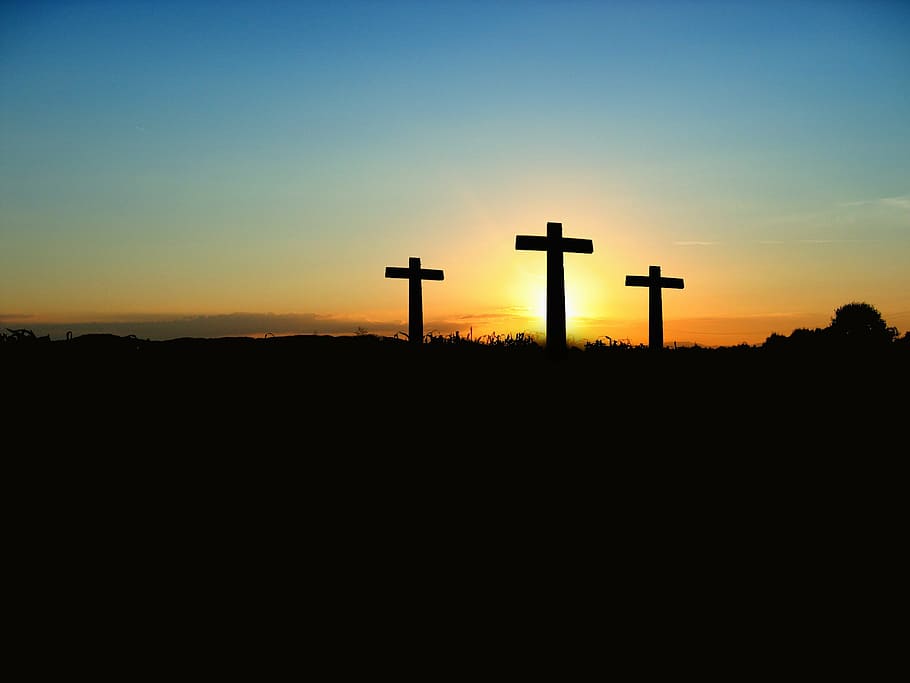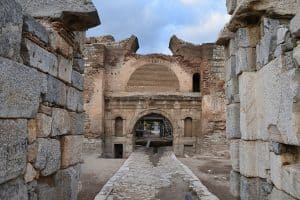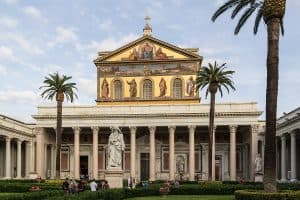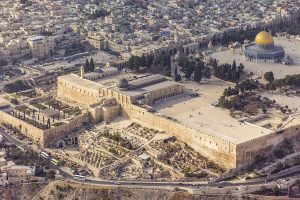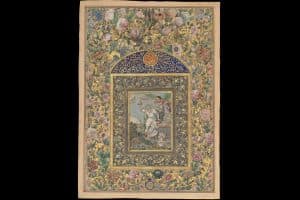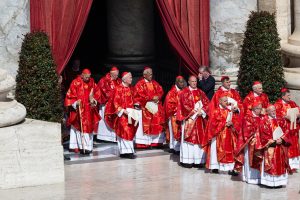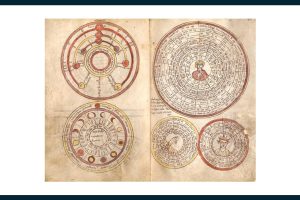Good Friday is the day in the Christian calendar when Christians commemorate the crucifixion of Jesus in Jerusalem 2,000 years ago
Christ’s death and resurrection form the central tenets of Christianity; his death came to be understood as a sacrifice for the sin of the whole world, and his resurrection as a victory over death. Good Friday comes towards the end of Holy Week, which begins with Palm Sunday and Jesus’s triumphal entry into Jerusalem. It ends with his arrest and trials, his execution by the Roman authorities, and his burial in a garden tomb.
Why is Good Friday called good?
The origin of the phrase Good Friday is not clear. There is evidence that the Anglo-Saxons called it “Long Friday” — and the Danes still use this term. The Oxford English Dictionary cites a reference to “Guode Friday” in a late 13th-century text about the lives of the saints, the South English Legendary, suggesting that “guode” means “holy”. Others believe it may derive from the German “Gottes Friday” or “God’s Friday”.
How does the New Testament tell of the events leading up to the crucifixion?
The four gospels are our only sources for the events leading up to Jesus’s death. Although they tell broadly the same story, they differ in some significant details. Jesus was killed as Jews were preparing to celebrate the festival of Passover when Jerusalem would have been full of visitors. The city was under Roman occupation at the time.
The gospels tell the story of how Jesus was greeted by cheering crowds when he entered Jerusalem on a donkey. The first three gospels — known as the Synoptic Gospels — then report that Jesus entered the temple, overturned the tables of money-changers and cleared it of buyers and sellers (Mark 11:18-19).
In John’s Gospel, this event comes at the beginning of Jesus’s ministry. (John 2)
On the night before his death, after a meal with his friends — the Last Supper — Jesus went with his disciples to the Garden of Gethsemane. The gospels of Matthew and Mark write that he was arrested there by an armed crowd of people sent by the Jewish chief priests and elders. Luke mentions the “officers of the temple guard … who had come for him” (Luke 22:52).
John describes “a detachment of soldiers and some officials from the chief priests and Pharisees” (John 18:2). Scholars dispute whether the soldiers John alludes to were Roman.
How was he tried?
In the Synoptic Gospels, Jesus was questioned “at daybreak” (Luke 22:66) by the Sanhedrin, a council of chief priests and teachers of the law. In John’s Gospel, Jesus was questioned by Annas, the father-in-law of the high priest, Caiaphas, and then by Caiaphas himself. Annas had served as a high priest in 6-15AD.
The Jewish authorities handed Jesus over to Pontius Pilate, the Roman governor of Judaea, accusing him of blasphemy of subverting the nation, opposing the payment of taxes to Rome and claiming to be a king (Luke 23:2). Pilate questioned Jesus but did not find him guilty of a crime. The Jewish authorities did not have the power to sentence Jesus to death. Along with a crowd they put pressure on Pilate to have Jesus put to death.
Luke is the only gospel to give an account of Pilate sending Jesus for questioning by the Herod Antipas, the client ruler of Galilee and Perea, who was the son of Herod the Great. “Herod and his soldiers ridiculed and mocked him. Dressing him in an elegant robe they sent him back to Pilate.”
How did Jesus die?
Jesus was flogged, stripped and mocked, and led away to a place called Golgotha or the “place of the skull” to be crucified. A passer-by, Simon of Cyrene, was enlisted to help him carry his cross-beam (Mark 15:21).
Jesus was crucified between two criminals or “rebels” (Luke 15:27). According to Luke’s gospel one of them reviled him, but the other protests Jesus’s innocence and is promised a place with him in paradise. The suffering and death of Jesus was witnessed by a group of women, and, according to John’s Gospel, by “the disciple whom Jesus loved” — possibly the apostle himself.
Between them, the gospels record “seven words of Jesus on the cross” from the cross. Jesus’s final words in Matthew and Mark are a quote from Psalms 22: “My God, my God why hast thou forsaken me?” In Luke his last words draw on Psalms 31: “Father into your hands I commend my spirit.” In John he says: “It is finished.”
A series of supernatural events accompanied the death of Jesus: darkness covered the land between noon and three o’clock, and the curtain of the temple was torn in two (Luke 23:45). Matthew also reports an earthquake. “The earth shook, the rocks split and the tombs broke open. The bodies of many holy people who had died were raised to life” (Matthew 27:51-52).
The gospel writers were concerned to show how the events surrounding Jesus’s crucifixion were fulfilments of Old Testament prophecies. For example, soldiers cast lots to decide who would keep Jesus’s clothes (John 19:24; Psalms 22:18); they did not break Jesus’s legs to ensure he was dead but pierced his side (John 19:33-34; Psalms 34:20; Zechariah 12:10).
Pilate gave permission for Jesus’s body to be taken by Joseph of Arimathea who, according to legend, later brought the Holy Grail — the cup Jesus used at the Last Supper — to Glastonbury in England. We are told that Joseph was a member of the Jewish Sanhedrin who had not agreed with its decision to seek the death of Jesus (Luke 23:50). According to John’s Gospel, he and another of Jesus’s followers, Nicodemus, followed Jewish customs in preparing the body for burial, before laying it in a garden tomb that had never been used.
Who killed Jesus and why?
The gospels seek to exonerate Pilate for his role in the crucifixion of Jesus and lay the blame squarely on his Jewish critics and opponents. Parts of their accounts have been used to justify centuries of violent antisemitism. In Matthew’s Gospel, Pilate washes his hands in front of the crowd, claiming he is innocent of Jesus’s blood. “All the people answered, ‘His blood is on us and on our children’” (Matthew 27:24-25), a verse that has been weaponised to terrifying effect. John’s Gospel is particularly criticised for its anti-Jewish polemic.
The gospels record numerous examples of conflict between Jesus and the Jewish leaders of his day. It is debatable how much the Romans would have concerned themselves with the details. However, claims that Jesus either understood himself or was understood by others to be the Messiah (divinely appointed king) would have sounded alarm bells. This would especially be the case during Passover, a politically sensitive time when Jews celebrated their liberation from slavery in Egypt.
Crucifixion was the Roman method of executing political agitators. That Jesus was put to death in this way is evidence that, historically speaking, Jesus died because the Romans viewed him as a political threat.
Where was Jesus buried?
The traditional site of Jesus’s crucifixion, burial and resurrection is now marked by the Church of the Holy Sepulchre in Jerusalem, said to have been commissioned by Emperor Constantine the Great after a visit by his mother Helena to the site in the fourth century. The church houses a rocky outcrop said to be Calvary and the remains of a first-century tomb. It is now covered by an elaborate shrine.
Another site claimed for these events is the so-called Garden Tomb, just outside the city walls near Damascus gate and discovered in 1867.
How is Good Friday commemorated?
Christians around the world observe Good Friday by following 14 “stations of the cross” that mark the journey of Jesus to his crucifixion. The stations are told in images, beginning with Pilate condemning Jesus to death and ending with his burial. Not all the stations are recorded in the gospels — for instance there is no report of Veronica wiping Jesus’s face or of him falling three times.
The most famous Good Friday observance takes place in Jerusalem’s Old City where pilgrims follow the Via Dolorosa (“Sorrowful Way”), the route Jesus is believed to have taken to Golgotha. In Rome the Pope leads pilgrims in the Way of the Cross to the Colosseum. Elaborate public dramas take place throughout the Christian world. The Oberammergau Passion Play in Bavaria, first performed in 1634, is staged every 10 years to honour the vow made by the villagers to re-enact the passion if God spared them from the plague. In Mexico City a week-long re-enactment of Christ’s Passion, dating from the mid-19th century, now attracts up to two million visitors.
Further research:
Religion Media Centre Factsheet on Easter and the Resurrection by Rev Dr Andy Byers, Ridley Hall, Cambridge
Professor N T Wright, Research Professor Emeritus of New Testament and Early Christianity at St Mary’s College, University of St Andrews

